Controverscial.Com
![]()
Welcome
![]()
|
Controverscial.Com
Welcome
|
|
|
Controverscial.Com
Welcome
|



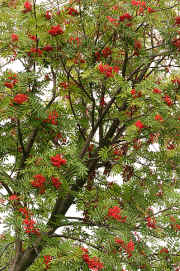
The Rowan tree (Sorbus aucuparia) is one of the sacred trees of Wicca/Witchcraft and of old was a favoured tree of the ancient Druids. According to the Beth-Luis-Nion calendar, a reconstruction by Robert “von Ranke” Graves (author of The White Goddess), the Rowan tree is the second tree of the ancient Celtic Tree Calendar (21st January – 17th February). As such it is associated with Imbolc (2nd February) one of the four Greater Sabbats sacred to the Goddess Bridget.
Native to the cooler temperate regions of the Northern Hemisphere, the greatest density of the species (over 100) can be found up in the mountainous areas of western China, the Himalayas, Russia and the Caucasus mountain ranges - for this reason the Rowan tree is more commonly known as the Mountain Ash. It is also known by many other names: Lady of the Mountains, Delight of the Eye, Ran Tree, Roynetree, Roden Quicken, Quickbane, Sorb Apple, Thor’s Helper, Whitty, Wicken-Tree, Wiky, Wiggin, Wiggy, Wild Ash, Witchwood, Witchbane and Witchen. Botanically the Rowan tree is of the rose family Rosaceae, and of the genus Sorbus.
Rowan trees are mostly small deciduous trees and while some of its species may be considered a shrub, as a tree it typically grows to between 4-12 m (13-39 ft) in height. In its common form the Rowan grows as a slim multi-stemmed tree with upwardly pointing branches, the bark of which is a shiny greyish-brown with raised dots or lenticels scattered across it.
The leaves of the Rowan arrange themselves alternately on either side of a central stem, and they are pinnate in form with a terminal leaflet at the end. Commonly the stem grows to about 20 cm (7 in) in length and comprises 9-15 leaflets that are serrated with small teeth. Being a deciduous tree, after shedding its leaves in the winter, new green leaves begin to appear in April, and by autumn turn to a bright orangey red colour, before again being shed for the winter.
The five-petalled creamy-white flowers of the Rowan tree appear and blossom after its leaves in April, usually in May or early June. Individually they grow in dense domed clusters of up to 250, which can measure up to 8-15 cm (3-6 in) across. Cross-pollination is effected by insects, such as flies, bees and beetles, after which by the end of June the flowers fade to be
replaced by berry-like fruits measuring 6 to 9 mm (¼ to ½ in) in diameter. The seed bearing fruits ripen in August or early September, when their brilliant bright red colour lends a stark contrast to the surrounding green foliage. Birds primarily feed on the berries and disperse the seeds in their droppings aiding propagation.
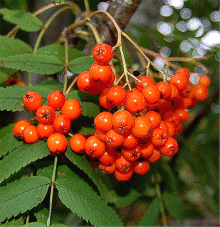
The wood of the Rowan tree is dense and tough, and used in the past for making ship’s masts, poles and whips. Being dense, it is a useful wood for carving and turning, and of old, tool handles, spindles, spinning-wheels, barrel hoops and walking sticks were all commonly made from its wood. Magically, Rowan wood has traditionally been used for making Druid’s staffs, and its branches used for dowsing or divining. Magic wands made from Rowan are thought to be especially effective in ritual when psychic intuition is required. The bark was used for tanning and as a dye, usually black.
The berries of the Rowan are edible and are used to make a bitter tasting jelly, which in Britain was traditionally eaten as an accompaniment to game. They can also be used to make jams and other preserves, eaten on their own or combined with other fruits. At one time they were used as a substitute for coffee beans, but today are more commonly used in alcoholic beverages for added flavour or producing country wines.
Of old, during the month of May, farmers passed all their livestock through a large hoop made of Rowan to protect them and
ensure fertility. Benevolent fairies are said to have inhabited the Rowan, which if grown near the home would protect its
occupants from evil spirits. A piece of Rowan was often sown into the clothing of small children to protect them from
capture by evil fairies. Often red berries, after being left to soak in water, were sprinkled around areas one wished to protect.
In Scandinavian myths, the first woman was formed from the Rowan tree and the first man from Alder tree. The red berries of the Rowan were considered sacred by most cultures and are symbolic of the forces of creation - blood, life, death and renewal. The old peoples of Ireland believed that the Rowan possessed the power to restore lost youth and was guarded by serpents and dragons. They also associated Rowan with Bridget and Brigantia whose arrows were made from Rowan wood.
In Aegean/Mediterranean myths, the Rowan is connected to a tale about the drinking cup of Zeus, which was stolen from Olympus. An eagle was sent to recover the cup and a battle raged with the creatures that stole it. The legend has it that wherever a drop of blood or feather fell during the battle, a Rowan tree subsequently sprouted. Similarly, the red berries of the Rowan are symbolically associated with droplets of blood and are used by many contemporary pagans and witches as such during ritual and magick. Gone are the days when real sacrificial blood was used.
Rowan wood can be carried and used to increase psychic powers, and its branches used for making dowsing rods or magical wands. The leaves and berries of the Rowan can be added to incense to aid divination and increase psychic powers. The bark and berries carried on the person will also aid in recuperation, and was added to health and healing sachets, as well as power, luck and success charms.
Tying two small twigs of Rowan together with red thread in the form of an equal-armed cross is an age-old protective amulet. Cornish peasants carried these in their pockets for protection; as did Scottish Highlanders sew them into the lining of their kilts before going into battle. Walking sticks and staffs made from Rowan are excellent tools for those who roam the fields or woods by night, as well as an aid to walking; they offer protection from lightning. Similarly, when traveling across water, carrying a piece of Rowan will protect the ship from storms at sea.
When a family member dies, planting a Rowan tree over their grave would prevent their souls from haunting the place. The red berries of the Rowan have a five-pointed star (pentagram) from were it was attached to the stalk. The pentagram is an ancient symbol of protection and so carrying the berries in a pocket would protect a person from harm. Highland women made necklaces of the berries threaded with red thread for protection. The Rowan was thought to help a person distinguish good from bad, help from harm, and friend from foe. Spiritually, it protected you from unwanted influences and symbolized beauty, privacy, peace and sanctuary.
The Rowan has deity associations with the gods: Dagda, Thor, Vulcan, Pan and Herne, and with the goddess: Bridget, Brigantia, Aphrodite, Cerridwen and Hecate. Its gender type is Masculine. Its planetary ruler is the Sun and its associated elements Earth and Fire. Rowan is used to attract the powers needed for: Protection, Healing, Success and Psychic Powers.
Astrologically, Rowan people (i.e. those people born during the period 21st Jan – 17th Feb) are protective and full of charm, cheerful, gifted and without egoism. They like to draw attention, love life, motion, unrest and even complications. They are both dependent and independent, have good taste and are artistic and passionate. While sociable and good company, they can also be emotional, and do not forgive or forget.
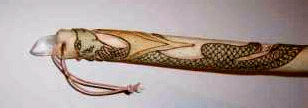
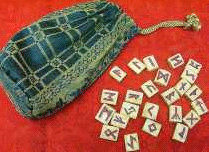
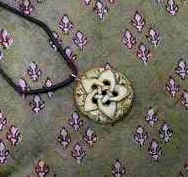
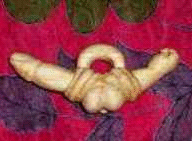

Rowan woodcrafts by the Witch of Forest Grove - http://witchofforestgrove.com/
My grateful thanks to Sarah Lawless
Cunningham's
Encyclopedia Of Magical Herbs
- By Scott Cunningham.
Encyclopedia
of Wicca & Witchcraft
- By Raven Grimassi.
Tree
Wisdom: The
definitive guidebook to the Myth, Folklore and Healing Power of Trees - By
Jacqueline Memory Paterson.
AA
Book of Britain's Countryside.
The
Penguin Hutchinson Reference Library
(CD cassette).
Microsoft
Encarta Encyclopedia
(CD cassette).
Plus
many websites too numerous to mention.
![]()
![]()
First published February 2002 - Updated December 2008 © George Knowles
![]()

Let there be peace in the world - Where have all the flowers gone?
My Personal Page / My Place in England, UK / My Family Tree (Ancestry)
Wicca/Witchcraft / What is Wicca / What is Magick
Traditional Writings:
Wiccan Rede / Charge of the Goddess / Charge of the God / The Three-Fold Law (includes The Law of Power and The Four Powers of the Magus) / The Witches Chant / The Witches Creed / Descent of the Goddess / Drawing Down the Moon / The Great Rite Invocation / Invocation of the Horned God / The 13 Principles of Wiccan Belief / The Witches Rede of Chivalry / A Pledge to Pagan Spirituality
Correspondence Tables:
Incense / Candles / Colours / Magickal Days / Stones and Gems / Elements and Elementals
Traditions Part 1 - Alexandrian Wicca / Aquarian Tabernacle Church (ATC) / Ár Ndraíocht Féin (ADF) / Blue Star Wicca / British Traditional (Druidic Witchcraft) / Celtic Wicca / Ceremonial Magic / Chaos Magic / Church and School of Wicca / Circle Sanctuary / Covenant of the Goddess (COG) / Covenant of Unitarian Universalist Pagans (CUUPS) / Cyber Wicca / Dianic Wicca / Eclectic Wicca / Feri Wicca /
Traditions Part 2 - Gardnerian Wicca / Georgian Tradition / Henge of Keltria / Hereditary Witchcraft / Hermetic Order of the Golden Dawn (H.O.G.D.) / Kitchen Witch (Hedge Witch) / Minoan Brotherhood and Minoan Sisterhood Tradition / Nordic Paganism / Pagan Federation / Pectic-Wita / Seax-Wica / Shamanism / Solitary / Strega / Sylvan Tradition / Vodoun or Voodoo / Witches League of Public Awareness (WLPA) /
Gods and Goddesses (Greek
Mythology) / Esbats &
Full Moons / Links
to Personal Friends & Resources / Wicca/Witchcraft
Resources / What's a spell? /
Circle Casting and
Sacred Space / Pentagram
- Pentacle / Marks
of a Witch / The Witches
Power / The Witches Hat
/ An
esoteric guide to visiting London / Satanism
/ Pow-wow
/ The
Unitarian Universalist Association / Numerology: Part 1
/ Part 2 / Part
3 / A
history of the Malleus Maleficarum: includes: Pope
Innocent VIII /
The
papal Bull /
The
Malleus Maleficarum /
An extract from the Malleus Maleficarum
/ The letter of approbation
/ Johann
Nider’s Formicarius /
Jacob
Sprenger /
Heinrich Kramer /
Stefano Infessura
/ Montague Summers /
The Waldenses
/ The Albigenses
/
The Hussites / The
Sun Dance
/ Shielding (Occult
and Psychic Protection) /
Sabbats in History and Mythology / Samhain (October 31st) / Yule (December 21st) / Imbolc (February 2nd) / Ostara (March 21st) / Beltane (April 30th) / Litha (June 21st) / Lughnasadh (August 1st) / Mabon (September 21st)
Rituals contributed by Crone: Samhain / Yule / Imbolc / Ostara / Beltane / Litha / Lammas / Mabon
Tools of a Witch / The Besom (Broom) / Poppets and Dolls / Pendulums / Cauldron Magick / Mirror Gazing
Animals in Witchcraft (The Witches Familiar) / Antelope / Bats / Crow / Fox / Frog and Toads / Goat / Honeybee / Kangaroo / Lion / Owl / Phoenix / Rabbits and Hares / Raven / Robin Redbreast / Sheep / Spider / Squirrel / Swans / Wild Boar / Wolf / Serpent / Pig / Stag / Horse / Mouse / Cat
In Worship of Trees - Myths, Lore and the Celtic Tree Calendar. For descriptions and correspondences of the thirteen sacred trees of Wicca/Witchcraft see the following: Birch / Rowan / Ash / Alder / Willow / Hawthorn / Oak / Holly / Hazel / Vine / Ivy / Reed / Elder. Also see: The Willow Tree (Folk Music)
Mystical Sacred Sites - Stonehenge / Glastonbury Tor / Malta - The Hypogeum of Hal Saflieni / Avebury / Cerne Abbas - The Chalk Giant / Ireland - Newgrange /
Rocks and Stones:
Stones - History, Myths and Lore
Articles contributed by Patricia Jean Martin: / Apophyllite / Amber / Amethyst / Aquamarine / Aragonite / Aventurine / Black Tourmaline / Bloodstone / Calcite / Carnelian / Celestite / Citrine / Chrysanthemum Stone / Diamond / Emerald / Fluorite / Garnet / Hematite / Herkimer Diamond / Labradorite / Lapis Lazuli / Malachite / Moonstone / Obsidian / Opal / Pyrite / Quartz (Rock Crystal) / Rose Quartz / Ruby / Selenite / Seraphinite / Silver and Gold / Smoky Quartz / Sodalite / Sunstone / Thunderegg / Tree Agate / Zebra Marble
Wisdom:
Knowledge vs Wisdom by Ardriana Cahill / I Talk to the Trees / Awakening / The Witch in You / A Tale of the Woods
Articles and Stories about Witchcraft:
Murder by Witchcraft / The Fairy Witch of Clonmel / A Battleship, U-boat, and a Witch / The Troll-Tear (A story for Children) / Goody Hawkins - The Wise Goodwife / The Story of Jack-O-Lantern / The Murder of the Hammersmith Ghost / Josephine Gray (The Infamous Black Widow) / The Two Brothers - Light and Dark
Old Masters of Academia:
Pliny the Elder / Hesiod / Pythagoras
Abramelin the Mage / Agrippa / Aidan A. Kelly / Albertus Magnus “Albert the Great” / Aleister Crowley “The Great Beast” / Alex Sanders "the King of the Witches” / Alison Harlow / Amber K / Anna Franklin / Anodea Judith / Anton Szandor LaVey / Arnold Crowther / Arthur Edward Waite / Austin Osman Spare / Biddy Early / Bridget Cleary / Carl Llewellyn Weschcke / Cecil Hugh Williamson / Charles Godfrey Leland / Charles Walton / Christina Oakley Harrington / Damh the Bard (Dave Smith) / Dion Fortune / Dolores Aschroft-Nowicki / Dorothy Morrison / Doreen Valiente / Edward Fitch / Eleanor Ray Bone “Matriarch of British Witchcraft” / Dr. John Dee and Edward Kelly / Dr. Leo Louis Martello / Eliphas Levi / Ernest Thompson Seton / Ernest Westlake and the Order of Woodcraft Chivalry / Fiona Horne / Friedrich von Spee / Francis Barrett / Gerald B. Gardner / Gavin and Yvonne Frost and the School and Church of Wicca / Gwydion Pendderwen / Hans Holzer / Helen Duncan / Herman Slater "Horrible Herman" / Israel Regardie / James "Cunning" Murrell / Janet Farrar & Gavin Bone / Jessie Wicker Bell “Lady Sheba” / John Belham-Payne / John George Hohman / John Gerard / John Gordon Hargrave (the White Fox) / John Michael Greer / John Score / Johannes Junius the Burgomaster of Bamberg / Joseph John Campbell / Karl von Eckartshausen / Laurie Cabot "the Official Witch of Salem" / Lewis Spence / Margaret Alice Murray / Margot Adler / Marie Laveau the " Voodoo Queen of New Orleans" / Marion Weinstein / Matthew Hopkins “The Witch-Finder General” / Max Ehrmann and the Desiderata / Monique Wilson the “Queen of the Witches” / Montague Summers / Nicholas Culpeper / Nicholas Remy / M. R. Sellers / Mrs. Grieve "A Modern Herbal" / Oberon and Morning Glory Zell-Ravenheart / Old Dorothy Clutterbuck / Old George Pickingill / Paddy Slade / Pamela Colman-Smith / Paracelsus / Patricia Crowther / Patricia Monaghan / Patricia “Trish” Telesco / Philip Emmons Isaac Bonewits / Philip Heselton / Raymond Buckland / Reginald Scot / Robert Cochrane / Robert ‘von Ranke’ Graves and "The White Goddess" /
Rudolf Steiner / Rosaleen Norton “The Witch of Kings Cross” / Ross Nichols and The Order of Bards, Ovates & Druids / Sabrina - The Ink Witch / Scott Cunningham / Selena Fox / Silver Ravenwolf / Sir Francis Dashwood / Sir James George Frazer / S.L. MacGregor Mathers and the “Hermetic Order of the Golden Dawn” / Starhawk / Stewart Farrar / Sybil Leek / Ted Andrews / The Mather Family - includes: Richard Mather, Increase Mather, Cotton Mather / Thomas Ady / Vera Chapman / Victor Henry Anderson / Vivianne Crowley / Walter Brown Gibson / William Butler Yeats / Zsuzsanna Budapest
Many of the above biographies are brief and far from complete. If you know about any of these individuals and can help with aditional information, please cantact me privately at my email address below. Many thanks for reading :-)
While I have taken due care and dilligence to credit all sources where possible, this website may contain copyrighted material which has not been specifically authorized by the copyright owner. My use of making such material available here is done so in my efforts to advance our understanding of religious discrimination, the environmental and social justice issues etc. If you wish to use copyrighted material from this wedsite for purposes of your own then you must obtain permission from the relevant copyright owner yourself.
![]()
My online email discussion group:
http://groups.yahoo.com/group/Email_Witches

Help send a message of peace around the world! The Dove of Peace flies from site to site, through as many countries as possible. It does not belong to ANY belief system. Please help make a line around the globe by taking it with you to your site, by giving it to someone for their site, by passing it on to another continent or to the conflict areas of the world. May trouble and strife be vanquished in it's path.

mailto:George@controverscial.com
![]()
|
|